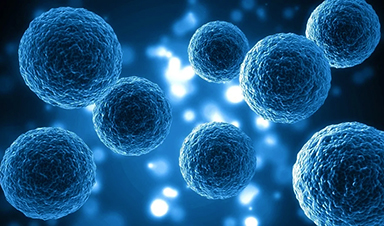Cell signaling is crucial for cells to communicate and function correctly. Disruptions in these pathways, caused by genetic mutations or environmental factors, can lead to uncontrolled cell growth, improper immune responses, or errors in development. These dysregulations are the basis for diseases like cancer, diabetes, and autoimmune disorders.
What is cell signaling?
Cell signaling involves the different stages in which cells communicate with each other and their environment. It is a complex process involving a series of steps that allow cells to receive, process (transduction), and respond to signals.1
In order to communicate with each other, cells require key components, such as receptors, signaling molecules, target proteins, as well as scaffold proteins and second messenger molecules.1
Cell signaling receptors are proteins on the cell surface or inside the cell that bind to specific signaling molecules.1 These receptors can identify and translate different external stimuli, such as mechanical, chemical, or electrical stimuli, into a chemical language that the cell can understand and respond to.1
These mechanisms are called mechanotransduction, electrotransduction, and chemotransduction, respectively. Signaling molecules are molecules that carry signals from one cell to another.1 They can be hormones, neurotransmitters, growth factors, or other molecules.1
Target proteins reside inside the cell and are activated or deactivated by the signaling pathway, leading to a specific cellular response.1 In the same context, a variety of other molecules are required for the proper progression or development of a signaling pathway. These are second messengers and scaffold proteins.1
Second messengers, as the name implies, carry the information received by the specific receptor but amplify it so that the response can spread throughout the entire cell, and responses can be more efficient and rapid.1
Scaffold proteins are another key component, as they help to assemble protein complexes and reduce physical distances between crucial proteins in the signaling pathways.1 They participate in constructing these macromolecular complexes needed for a proper signaling response.1
How cell signaling goes wrong
Cell signaling is crucial for maintaining proper bodily functions. However, disruptions to these signaling pathways, also called dysregulation, can contribute to various conditions like cancer, neurodegenerative disorders, and autoimmune diseases.
There are different causes of signaling dysregulation. Mutations can lead to malfunctioning signaling proteins, disrupting signal transmission. For example, mutations in genes encoding receptor tyrosine kinases (RTKs), such as epidermal growth factor receptor (EGFR) or fibroblast growth factor receptor (FGFR), are implicated in cancer development.2 Mutations in the RAS gene, a key regulator of cell growth, are also common in various cancers.3
Pathogens can hijack cellular signaling pathways for their benefit, disrupting normal cellular processes.4,5 For instance, the bacterium Helicobacter pylori alter signaling pathways in stomach cells, contributing to ulcer formation.4 This also happens in infections caused by parasites like Trypanosoma cruzi.5
Exposure to toxins, pollutants, radiation, or other environmental factors can interfere with cell signaling.6 In addition to cancers, impaired signaling also contributes to neuronal dysfunction in diseases like Alzheimer’s and Parkinson’s.7 In Alzheimer’s, altered processing of amyloid precursor protein disrupts signaling pathways crucial for neuronal survival.7
Dysregulation of cytokine signaling, which mediates immune responses, contributes to inflammation and tissue damage in autoimmune diseases like rheumatoid arthritis.8 It is important to note that a primary response against a pathogen can drive autoimmune disorders.9
The impact of dysregulated cell signaling
Dysregulated cell signaling has profound consequences for cellular behavior and overall health, leading to a range of pathological conditions.
Proper cell signaling tightly controls cell growth and division. Dysregulation can tip the balance, generating uncontrolled proliferation. Overactivation of pathways driven by growth factors like epidermal growth factor (EGF) or fibroblast growth factor (FGF) can fuel excessive cell division. Mutations in genes encoding receptors for these growth factors (EGFR and FGFR) are commonly observed in cancers.2

Dysregulation of cell cycle checkpoints, which ensure orderly progression through the cell division cycle, can allow cells with DNA damage to proliferate, contributing to genomic instability and tumor development.10
Additionally, cells have a programmed mechanism called apoptosis to eliminate damaged or non-functional cells.11 Dysregulation of these pathways allows damaged cells to survive, hindering the homeostatic cellular balance and potentially leading to the development of different diseases.11
A common feature of cancer cells is the acquisition of mutations that inactivate pro-apoptotic proteins or upregulate anti-apoptotic signals, allowing them to evade programmed cell death and continue proliferating.11
However, impaired apoptosis can lead to other disorders.11 For example, it contributes to the accumulation of misfolded proteins and cellular debris in neurodegenerative diseases like Alzheimer’s and Parkinson’s.11
Cells constantly encounter various stressors, and proper signaling is crucial for mounting appropriate responses.12 Dysregulation can compromise cellular adaptation to stress, leading to dysfunction and disease.12
In the same context, chronic inflammation, often driven by dysregulated cytokine signaling, can contribute to tissue damage and the development of chronic diseases like autoimmune disorders and cardiovascular diseases.13
Therapeutic targets and future directions
As dysregulated cell signaling drives numerous diseases, there is an urgent need for targeted therapies.14 Developing drugs that modulate specific signaling pathways holds immense promise for treating conditions like cancer, neurodegenerative diseases, and autoimmune disorders.1
For example, inhibitors of receptor tyrosine kinases (RTKs) have shown efficacy in cancers driven by aberrant RTK signaling.15 Nonetheless, the future of medicine lies in personalized approaches, tailoring treatments based on an individual’s genetic and molecular profile.14 This could involve identifying specific mutations driving disease and selecting drugs that precisely target those dysregulated pathways.14
Future research will increasingly focus on harnessing the power of omics technologies such as genomics or proteomics.16,17 By elucidating complex signaling networks and identifying novel therapeutic targets, scientists aim to develop therapies tailored to an individual’s unique molecular makeup.16,17
This approach promises to maximize efficacy while minimizing side effects.16,17 Through genomics, they can identify specific mutations that drive disease, enabling the selection of drugs that precisely target these dysregulated pathways.16,17
Proteomics can further refine this approach by identifying protein biomarkers that predict drug response or disease progression.16 The integration of these advances with a deeper understanding of cell biology will pave the way for truly personalized therapies and revolutionize the treatment of a wide range of diseases.17
References
- Su, J. et al. Cell-cell communication: new insights and clinical implications. Signal Transduct Target Ther 9, 196 (2024). https://doi.org/10.1038/s41392-024-01888-z
- Paul, M. K. & Mukhopadhyay, A. K. Tyrosine kinase – Role and significance in Cancer. Int J Med Sci 1, 101-115 (2004). https://doi.org/10.7150/ijms.1.101
- Simanshu, D. K., Nissley, D. V. & McCormick, F. RAS Proteins and Their Regulators in Human Disease. Cell 170, 17-33 (2017). https://doi.org/10.1016/j.cell.2017.06.009
- Alzahrani, S. et al. Effect of Helicobacter pylori on gastric epithelial cells. World J Gastroenterol 20, 12767-12780 (2014). https://doi.org/10.3748/wjg.v20.i36.12767
- Volpini, X. et al. Trypanosoma cruzi Exploits Wnt Signaling Pathway to Promote Its Intracellular Replication in Macrophages. Front Immunol 9, 859 (2018). https://doi.org/10.3389/fimmu.2018.00859
- He, K. et al. Environmental endocrine disruptor-induced mitochondrial dysfunction: a potential mechanism underlying diabetes and its complications. Front Endocrinol (Lausanne) 15, 1422752 (2024). https://doi.org/10.3389/fendo.2024.1422752
- Hampel, H. et al. The Amyloid-beta Pathway in Alzheimer’s Disease. Mol Psychiatry 26, 5481-5503 (2021). https://doi.org/10.1038/s41380-021-01249-0
- Alunno, A., Carubbi, F., Giacomelli, R. & Gerli, R. Cytokines in the pathogenesis of rheumatoid arthritis: new players and therapeutic targets. BMC Rheumatol 1, 3 (2017). https://doi.org/10.1186/s41927-017-0001-8
- Qiu, C. C., Caricchio, R. & Gallucci, S. Triggers of Autoimmunity: The Role of Bacterial Infections in the Extracellular Exposure of Lupus Nuclear Autoantigens. Front Immunol 10, 2608 (2019). https://doi.org/10.3389/fimmu.2019.02608
- Visconti, R., Della Monica, R. & Grieco, D. Cell cycle checkpoint in cancer: a therapeutically targetable double-edged sword. J Exp Clin Cancer Res 35, 153 (2016). https://doi.org/10.1186/s13046-016-0433-9
- Favaloro, B., Allocati, N., Graziano, V., Di Ilio, C. & De Laurenzi, V. Role of apoptosis in disease. Aging (Albany NY) 4, 330-349 (2012). https://doi.org/10.18632/aging.100459
- Butterfield, D. A. & Halliwell, B. Oxidative stress, dysfunctional glucose metabolism and Alzheimer disease. Nat Rev Neurosci 20, 148-160 (2019). https://doi.org/10.1038/s41583-019-0132-6
- Stergioti, E. M., Manolakou, T., Boumpas, D. T. & Banos, A. Antiviral Innate Immune Responses in Autoimmunity: Receptors, Pathways, and Therapeutic Targeting. Biomedicines 10 (2022). https://doi.org/10.3390/biomedicines10112820
- Ho, D. et al. Enabling Technologies for Personalized and Precision Medicine. Trends Biotechnol 38, 497-518 (2020). https://doi.org/10.1016/j.tibtech.2019.12.021
- Tomuleasa, C. et al. Therapeutic advances of targeting receptor tyrosine kinases in cancer. Signal Transduct Target Ther 9, 201 (2024). https://doi.org/10.1038/s41392-024-01899-w
- Duarte, T. T. & Spencer, C. T. Personalized Proteomics: The Future of Precision Medicine. Proteomes 4 (2016). https://doi.org/10.3390/proteomes4040029
- Olivier, M., Asmis, R., Hawkins, G. A., Howard, T. D. & Cox, L. A. The Need for Multi-Omics Biomarker Signatures in Precision Medicine. Int J Mol Sci 20 (2019). https://doi.org/10.3390/ijms20194781
News
Two New Books From Frank Boehm, NA Founder – To be Released Dec. 2025
Molecular Manufacturing: The Future of Nanomedicine This book explores the revolutionary potential of atomically precise manufacturing technologies to transform global healthcare, as well as practically every other sector across society. This forward-thinking volume examines [...]
What could the future of nanoscience look like?
Society has a lot to thank for nanoscience. From improved health monitoring to reducing the size of electronics, scientists’ ability to delve deeper and better understand chemistry at the nanoscale has opened up numerous [...]
Scientists Melt Cancer’s Hidden “Power Hubs” and Stop Tumor Growth
Researchers discovered that in a rare kidney cancer, RNA builds droplet-like hubs that act as growth control centers inside tumor cells. By engineering a molecular switch to dissolve these hubs, they were able to halt cancer [...]
Platelet-inspired nanoparticles could improve treatment of inflammatory diseases
Scientists have developed platelet-inspired nanoparticles that deliver anti-inflammatory drugs directly to brain-computer interface implants, doubling their effectiveness. Scientists have found a way to improve the performance of brain-computer interface (BCI) electrodes by delivering anti-inflammatory drugs directly [...]
After 150 years, a new chapter in cancer therapy is finally beginning
For decades, researchers have been looking for ways to destroy cancer cells in a targeted manner without further weakening the body. But for many patients whose immune system is severely impaired by chemotherapy or radiation, [...]
Older chemical libraries show promise for fighting resistant strains of COVID-19 virus
SARS‑CoV‑2, the virus that causes COVID-19, continues to mutate, with some newer strains becoming less responsive to current antiviral treatments like Paxlovid. Now, University of California San Diego scientists and an international team of [...]
Lower doses of immunotherapy for skin cancer give better results, study suggests
According to a new study, lower doses of approved immunotherapy for malignant melanoma can give better results against tumors, while reducing side effects. This is reported by researchers at Karolinska Institutet in the Journal of the National [...]
Researchers highlight five pathways through which microplastics can harm the brain
Microplastics could be fueling neurodegenerative diseases like Alzheimer's and Parkinson's, with a new study highlighting five ways microplastics can trigger inflammation and damage in the brain. More than 57 million people live with dementia, [...]
Tiny Metal Nanodots Obliterate Cancer Cells While Largely Sparing Healthy Tissue
Scientists have developed tiny metal-oxide particles that push cancer cells past their stress limits while sparing healthy tissue. An international team led by RMIT University has developed tiny particles called nanodots, crafted from a metallic compound, [...]
Gold Nanoclusters Could Supercharge Quantum Computers
Researchers found that gold “super atoms” can behave like the atoms in top-tier quantum systems—only far easier to scale. These tiny clusters can be customized at the molecular level, offering a powerful, tunable foundation [...]
A single shot of HPV vaccine may be enough to fight cervical cancer, study finds
WASHINGTON -- A single HPV vaccination appears just as effective as two doses at preventing the viral infection that causes cervical cancer, researchers reported Wednesday. HPV, or human papillomavirus, is very common and spread [...]
New technique overcomes technological barrier in 3D brain imaging
Scientists at the Swiss Light Source SLS have succeeded in mapping a piece of brain tissue in 3D at unprecedented resolution using X-rays, non-destructively. The breakthrough overcomes a long-standing technological barrier that had limited [...]
Scientists Uncover Hidden Blood Pattern in Long COVID
Researchers found persistent microclot and NET structures in Long COVID blood that may explain long-lasting symptoms. Researchers examining Long COVID have identified a structural connection between circulating microclots and neutrophil extracellular traps (NETs). The [...]
This Cellular Trick Helps Cancer Spread, but Could Also Stop It
Groups of normal cbiells can sense far into their surroundings, helping explain cancer cell migration. Understanding this ability could lead to new ways to limit tumor spread. The tale of the princess and the [...]
New mRNA therapy targets drug-resistant pneumonia
Bacteria that multiply on surfaces are a major headache in health care when they gain a foothold on, for example, implants or in catheters. Researchers at Chalmers University of Technology in Sweden have found [...]
Current Heart Health Guidelines Are Failing To Catch a Deadly Genetic Killer
New research reveals that standard screening misses most people with a common inherited cholesterol disorder. A Mayo Clinic study reports that current genetic screening guidelines overlook most people who have familial hypercholesterolemia, an inherited disorder that [...]





















